|
Mid-Winter Solstice Celebration Holiday 2015

A fabulous week holiday in Luxor visiting many ancient sites culminating in celebrating the mid-winter solstice at the magnificent temple of Queen Hatshepsut.
14th - 21st December 2015: Click here for details. |
 The following section has been contributed by Malcolm Stewart The following section has been contributed by Malcolm Stewart
The “Flower of Life” and
the Osirion –
Facts are more interesting than Fantasy
The “Flower of Life” circle clusters appear on stone surfaces of the Osirion and are believed by some to be 6000 years old. There is no evidence at all for this but there is strong evidence for a very approximate later dating; this evidence has been ignored by enthusiasts for the exotic prehistoric theories that have been woven around the early date.
The Osirion itself is almost certainly far older than the adjacent New Kingdom Temple of Seti I. The “Flower” wall engraving however, from its positioning, execution and content, shows no signs of being contemporaneous with the construction of the building itself.
Close study of David Furlong’s photos of the various versions of the figure, at various stages of geometric development, that appear on the squared column, shows that amid the circle clusters there is a lot of writing. It is clearly visible as such. Though no translation can be hazarded yet, many individual letters can be read. They are Greek - perhaps archaic Greek, judging from some of the letter-forms e.g. the digamma (an F shape derived from the Phoenician) that denotes the number 6. See David’s photos below here
 |
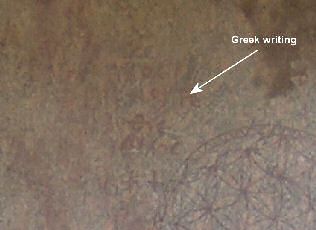 |
It is surprising, or maybe not, that those who suggest mysterious pre-historic origins to the cluster, never seem to mention the written graffiti. More on this later … |
The letters make the same kind of graphic impression on the granite, and seem very possibly to be in the same hand, as the circles.
Greek writing certainly did not exist 6000 years ago. (No alphabet did.) It suggest that this graffiti dates broadly from within the time from Alexander in the 4th century BC (or, just possibly, earlier when Greek philosophers such as Thales and Pythagoras visited Egypt) through to 400 or so AD.
It’s also worth noting that the Roman Mediterranean world popularly used “Koine” a form of Greek, throughout its period of dominance. The pattern itself is a commonplace underlying lattice for Roman hexagonal and circle cluster tiling. Its occurrence at the Osirion is certainly intriguing but it is ludicrous the turn it into a kind of prehistoric “mystery”.
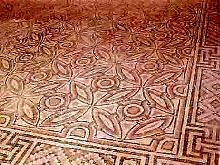 |
 |
In an area of Hellenic influence the pattern surfaces as mosaic tiling in Sephoris (Zippora, Galilee). This Roman urban development, involving a theatre, stadium and Stoa, was the largest Roman building project of its time. It was under construction within a few miles of Nazareth during the time when the young Jesus would have been serving his apprenticeship. |
The fact is that anytime one uses a honeycomb design, or a derivative from such a design, the underlying geometry requires that one makes a circle cluster of the type recently been dubbed the “Flower of Life”.
When one looks at the many versions that were extant in the Roman world one can assume that the cluster on the Osirion column was quoting and exploring something seen elsewhere. This is particularly suggested by the border circle that is roughly denoted, furnishing an impression rather than providing the more exact geometry of the circles themselves. It could also represent the sketches of a designer working out the pattern to be used elsewhere. Designers “work boards” rarely get found but any designer will know that they are the place where graphic experimentation and preparatory work gets done before the execution of a project. (There is an interesting much later example of just such a work board surface on a wall in the crypt of Roslyn Chapel – where a vesica piscis and further construction lines have been inscribed in the stone.) I think any other designers who study the full array of inscriptions on the Osirion surface will agree that the whole thing shows every evidence of being such a “work board” drawn on a convenient flat surface. By whom? Well, the site shows evidence of being much used over many centuries as is shown by other graffiti to be found nearby.
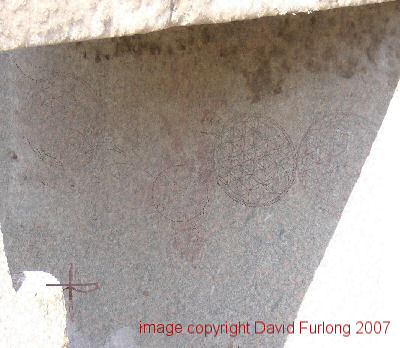 |
This enhanced picture highlighting the graffiti on the column of the Osirion where many of the Flower of Life designs can be seen. |
Note on the written graffiti in Abydos
In the early 1900s Margaret Murray wrote a report as part of the team that first studied the Abydos site in modern times. She does not refer to the Osirion but her report has a whole chapter on the graffiti on the nearby Seti Temple walls. There is some rough Phoenician writing, Greek – dated mainly in the 3rd and 2nd centuries BC, and quite a bit of Coptic material dating from a time when the site was being used by a Christian community. The whole topic of graffiti elsewhere at that site, while proving nothing, fills in a sense that the place has had a lot of history and has had many occupants. Just because the Osirion looks to be very ancient does not mean that drawings and writings on the wall have anything to do with the first builders. One can see that the material was in no way “designed-in” to the surface, but rather use that surface in a haphazard way.
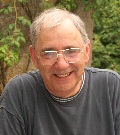 Malcolm Stewart Malcolm Stewart
I am a designer/lecturer/writer in the field of the liberal arts and sacred geometry. Below are a couple of pieces of my own that were based on hexagonal geometries facilitated by circle clusters.
The first was done in 1982. It is an early sketch representing the view looking up into a dome designed for a mosque. It was an original tessellation (i.e. it had not previously existed in Muslim sources). Its underlying design involved the development of a number of circle clusters on different scales. The second image is of a poster entitled “Jubilee Dawn”. This celebrates the traditional Jewish Jubilee concept 7 x 7 (49) – the Jubilee day, or year, occurring at 50. An echo of this is carried forward on the “Pentecost” of Christendom.
 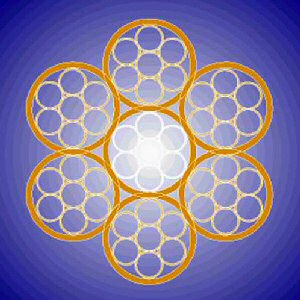
The Sand Reckoner’s Diagram
The “Flower of Life” is one of a number of richly productive matrices that are to be found throughout the long history of geometric design. The name itself – a recent invention – has tended to obscure its commonplace study and usage by designers and geometers down the centuries.
I have written book from nearly 40 years of study of another almost unknown matrix, that I believe to have been at the root of all our measurement and the ancient sexagesimal system of number – indeed to have kick-started the number lore and design techniques of agrarian/urban civilization itself.
The book is currently in preparation with publishers. It is entitled “The Sand Reckoner’s Diagram”. If you wish to be informed of its publication date please email me with your contact details:
mrmalcolmstewart@btinternet.com
Does Egypt call to you? Then why not join us for this trip?

|
For further information please write to:
David Furlong
Myrtles, Como Road, Malvern Worcs WR14 2TH
or phone 01684-569105 or 07779789047
Email:
David Furlong |
|
 -
The Osirion, which is located at the rear of the temple of Seti I at Abydos
-
 -
The Plan of the Osirion
The flower of life pattern is arrowed.
The Oldest Known Example of the 'Flower of Life' design
The oldest known example of the 'Flower of Life' design comes from the palace, in Nineveh, of the Assyrian king Ashurbanipal and is dated to c.645 BCE. This design in gypsum/alabaster formed a doorway threshold to the palace and is thought to have represented a carpet. This piece measuring 2.07 x 1.26 m can now be seen in the Assyrian rooms of the Louvre Museum in Paris.
.jpg)
Click to enlarge
.jpg)
Detail of floor supposedly representing a carpet. Click to enlarge
Note:
Margaret Murray excavated part of the Osirion in 1903. However she did not complete the excavation on the section where the "Flower of Life" design can be seen. This was not carried out until 1933 by H. Frankfort. No mention was made in his survey report of any Greek or Coptic graffiti.
Margaret Murray states in her Survey Extract 1903
"In Coptic times the temple was used as a nunnery, and the walls are covered in many places,
with inscriptions in the characteristic red paint of the Copts... some had faded away during
the time the temple was used as a Christian Church and fresh inscription painted over them. The
black was not so permanent as the red, and had vanished almost entirely."
|





